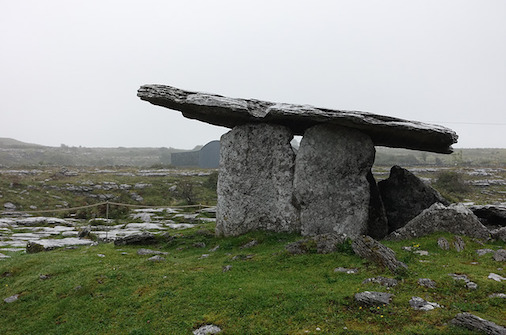Poulnabrone dolmen is an example of a portal dolmen or portal tomb, not to be confused with passage tombs such as Newgrange! Dolmens are found in Ireland and throughout the world and are generally characterized as a single-chamber megalithic tomb, often consisting of three or more upright stones (megaliths) supporting a large flat horizontal capstone (table). (1)

What is a dolmen?
Dolmens are thought to have been ancient tombs or burial markers and also served as places for ritual and worship although their exact purpose and significance is still debated by scholars and researchers. There are dolmen sites throughout Europe and Asia, including the dolmen Er Roc’h Feutet (Roch-Feutet) in Carnac, France, the Monte Bubbonia in Sicily, several in Gochang, South Korea and in Kerala, India.
Dolmens in Ireland
There are around 180 dolmens in Ireland known by many different names including stone tables, Cromleachs, or Giants’ Graves. They feature in Irish mythological stories and folklore and are often associated with graves of famous giants or warriors. (2)

Poulnabrone Dolmen
Located in the Burren, County Clare, Ireland the Poulnabrone dolmen dates to 4200 BCE and stands almost 6 feet high and 12 feet long. In his article on Poulnabrone for Ancient History, Joshua J. Mark explains that all the stones used in the construction of the dolmen were brought to the site from elsewhere as none match the geological make-up of the Burren and were then assembled with perfect balance and precision without concrete or any kind of compound. (3)
Poulnabrone is one of the few Irish portal tombs to have been archaeologically investigated. (4) In the 1980s archaeologist Ann Lynch found the remains of 22 people from the Neolithic Age buried in the dolmen after excavations. She proposed that the bodies were brought to the tomb after decomposition had occurred thereby suggesting an elaborate and complex burial ritual. (3)

Along with the bodies, Lynch also unearthed a variety of artefacts including a polished stone axe, a decorated bone pendant, several shards of pottery and two stone beads. These discoveries have led to the theory that those buried in the megalithic tomb were of a high or special standing in the community although why exactly these individuals were chosen remains a mystery.
The Spiritual Significance of Poulnabrone Dolmen
As Marks points out, the capstone of the tomb is set at an angle and the remains of the 22 bodies where found at the front, towards the highest point of the roof. This placement, it is thought, enabled the soul of the deceased to depart quickly and easily down to the afterlife or the Otherworld. (3) The descension is not thought to be connected with the later notion of Hell; rather, the “underworld” here is simply one realm of the Otherworld. Another theory as to the positioning of the stones suggests that instead of helping souls descend to the next life, the dolmen prevented evil spirits from entering this world.
As no scripts of any kind have been found to explain the significance of the Poulnabrone dolmen or other portal tombs, their exact purpose still remains a captivating mystery. What is known for sure, however, about these portal tombs is their enduring popularity – the megalithic tomb at Poulnabrone is one of Ireland’s most photographed archaeological site and a must-see for visitors to this beautiful isle.
Join our upcoming journey to Ireland in September 2019 with Tour Leader Phil Cousineau although we will not visit Poulnabrone Dolmen this time, you will discover the beauty and richness of Connemara. A few spots remain on this exquisitely crafted retreat – book yours today!
~ Sacred Earth Journeys
References:
(1) http://www.newworldencyclopedia.org/entry/Dolmen
(2) http://www.carrowkeel.com/files/dolmens.html
(3) http://www.ancient.eu/Poulnabrone/
(4) http://irisharchaeology.ie/2013/06/poulnabrone-tomb-life-and-death-in-the-burren/
